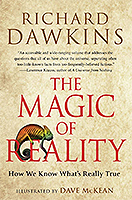 I just finished Richard Dawkins’ book for younger readers and/or a general audience, The Magic of Reality. It’s a general-interest science education book, written in Dawkins-speak – very conversational and emphatic about key points. It consists of a series of chapters about different topics, with each chapter guided by a big question, like “What is a rainbow?” or “What are things made of?” or “Who was the first person?” Dawkins opens the chapter with the recounting of myths from various cultures that attempt to answer those questions. These are delightful in the context of comparative anthropology, and I was delighted to see that the myths of the Hebrew tribes of the Middle East are mixed in with the stories of the Dogon of West Africa, Australian Aborigines, Scandinavian Vikings, and the Ainu of Japan. No special priority is given to any particular strain of non-scientific thinking. But don’t take that to mean that Dawkins is delivering his often scalding critique of religion in this book as he did in The God Delusion. This is toned down significantly from the approach he’s employed elsewhere. Anyhow, once the myths have been enjoyably recounted and no insight has been gained, Dawkins re-asks the question — “But what is a rainbow really?” and “Who was the first person really?” and then attempts to answer it as best he can. Some of these explanations are more compelling than others, based on what I assume is Dawkins’ familiarity with the source science. He’s spent a lot of time thinking about evolution, and as a result the answer to the “first person” question is elegant and excellent. He puts forth a terrific thought experiment wherein readers are asked to imagine building up a pile of portraits: your own on the bottom, with your father’s on top, and his father’s on top of that. One parent at a time, going back 185 million generations. Guess where you end up? …At a fish! Dawkins makes the point that each of these photos shows an organism that is the same species as the one before it and the one after it – no child is a different species than his or her father, no parent is a different species than his/her child. And yet, in a sequence like this, a thick enough stack of portraits in between two individuals would indeed render them different species. Evolution is (for the most part) a gradual process, and this thought experiment is an elegant way of demonstrating that concept. The book isn’t quite as strong when it comes to discussing the spectrum of light and earthquakes and atoms, but that’s like saying that Dickens isn’t Shakespeare: It’s still quite good, even if in some cases I had a quibble with the level of simplification chosen. Overall, The Magic of Reality would be an ideal book to give to an early teenager with a general interest in science.
I just finished Richard Dawkins’ book for younger readers and/or a general audience, The Magic of Reality. It’s a general-interest science education book, written in Dawkins-speak – very conversational and emphatic about key points. It consists of a series of chapters about different topics, with each chapter guided by a big question, like “What is a rainbow?” or “What are things made of?” or “Who was the first person?” Dawkins opens the chapter with the recounting of myths from various cultures that attempt to answer those questions. These are delightful in the context of comparative anthropology, and I was delighted to see that the myths of the Hebrew tribes of the Middle East are mixed in with the stories of the Dogon of West Africa, Australian Aborigines, Scandinavian Vikings, and the Ainu of Japan. No special priority is given to any particular strain of non-scientific thinking. But don’t take that to mean that Dawkins is delivering his often scalding critique of religion in this book as he did in The God Delusion. This is toned down significantly from the approach he’s employed elsewhere. Anyhow, once the myths have been enjoyably recounted and no insight has been gained, Dawkins re-asks the question — “But what is a rainbow really?” and “Who was the first person really?” and then attempts to answer it as best he can. Some of these explanations are more compelling than others, based on what I assume is Dawkins’ familiarity with the source science. He’s spent a lot of time thinking about evolution, and as a result the answer to the “first person” question is elegant and excellent. He puts forth a terrific thought experiment wherein readers are asked to imagine building up a pile of portraits: your own on the bottom, with your father’s on top, and his father’s on top of that. One parent at a time, going back 185 million generations. Guess where you end up? …At a fish! Dawkins makes the point that each of these photos shows an organism that is the same species as the one before it and the one after it – no child is a different species than his or her father, no parent is a different species than his/her child. And yet, in a sequence like this, a thick enough stack of portraits in between two individuals would indeed render them different species. Evolution is (for the most part) a gradual process, and this thought experiment is an elegant way of demonstrating that concept. The book isn’t quite as strong when it comes to discussing the spectrum of light and earthquakes and atoms, but that’s like saying that Dickens isn’t Shakespeare: It’s still quite good, even if in some cases I had a quibble with the level of simplification chosen. Overall, The Magic of Reality would be an ideal book to give to an early teenager with a general interest in science.
